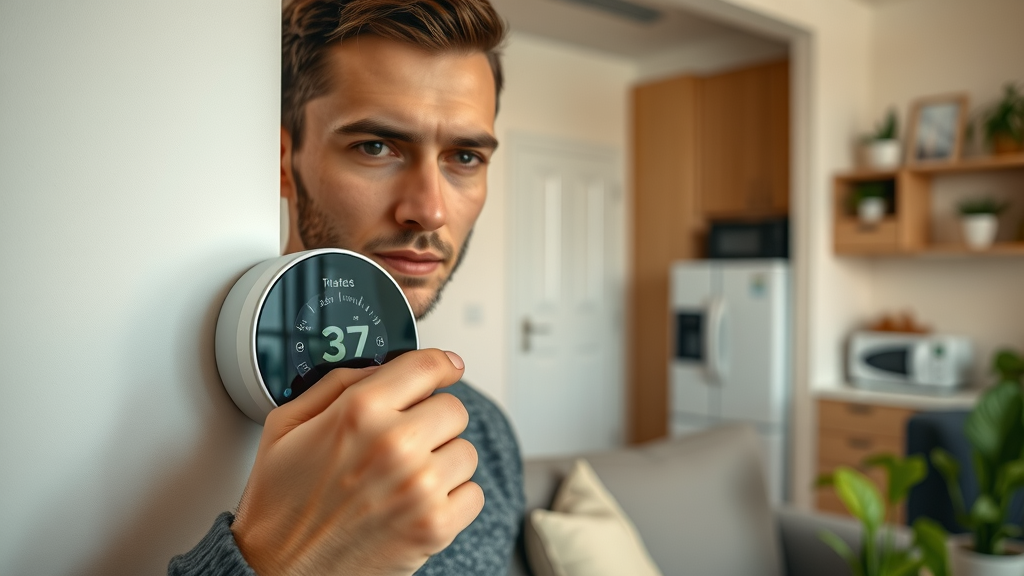Did you know that renewable energy heating solutions can slash your home’s carbon emissions by up to 80%—all while keeping your living spaces just as comfortable as ever? If you’re eager to cut your energy bills, maximize thermal energy savings, and join the low-carbon revolution, this guide will fast-track your knowledge. We’ll unlock lesser-known hacks, guide you through the top renewable heat technologies, and show you exactly how to future-proof your home—no matter its size or age. Ready to transform your space heating and hot water systems? Discover how today’s renewable energy heating innovations are reshaping homes everywhere.
Revolutionizing Home Comfort: Surprising Facts About Renewable Energy Heating

- Did you know that renewable energy heating solutions can cut household emissions by up to 80%?
- Shifting from traditional fossil fuel systems to renewable heat options like heat pumps and solar thermal dramatically reduces both carbon footprint and energy bills.
- With advanced thermal energy systems, today’s homes can achieve comfort, efficiency, and sustainability—all at once.
The transition to renewable energy heating isn’t just a trend—it’s a revolution in how we envision home comfort and sustainability. By moving away from conventional heat sources like natural gas or oil, homeowners are now leveraging advanced heat pump technology, solar thermal integrations, and geothermal systems to manage their space heating. These modern solutions use renewable energy sources—sun, air, ground, and water—to generate heat, often producing hot water and warm indoor air at a fraction of traditional costs.
The impact is transformative on several fronts. Not only does renewable heating slash harmful carbon dioxide emissions, but it also empowers households with greater energy independence and predictable costs. The latest research shows that, when combined with smart controls and insulation, these technologies can turn ordinary homes into high-performing, low-carbon sanctuaries—with superior comfort and air quality. This article will explore the top energy saving hacks, compare renewable heating systems, illustrate real-life success stories, and equip you to take the next step towards a cleaner, smarter home.
Maximizing Renewable Energy Heating for Sustainable Space Heating
Switching to renewable energy heating is about more than reducing bills—it’s about future-proofing your space heating, generating dependable hot water, and transforming your carbon output. As energy costs and climate concerns rise, smart homeowners are seeking sustainable, renewable heat solutions that make long-term sense. But where do you begin?
First, consider the greenhouse gas impact: Every traditional boiler or heating system powered by fossil fuels generates significant carbon emissions, directly contributing to global warming. With space heating accounting for roughly half of a typical household’s energy consumption in high-latitude countries, the opportunity for change is massive. Modern renewable heating technologies—such as ground source heat pumps, air-to-water heat pumps, and solar thermal panels—harness renewable energy sources instead, providing substantial emissions reductions and improved energy efficiency.
It’s also essential to include passive measures, like increased insulation and optimized thermal energy storage, to get the most out of any renewable heating system. When combined, these upgrades can cut both your energy consumption and carbon footprint dramatically, while maintaining a cozy interior climate year-round.
The Science Behind Renewable Heat and Its Impact on Your Home
Renewable heat draws on nature’s own thermodynamic processes to deliver steady, reliable comfort indoors. The science rests on the ability of certain systems—like heat pumps and solar panels—to absorb and transfer free energy from abundant sources. For instance, a heat pump extracts heat from outside air, the ground, or a nearby water source and 'pumps' this renewable heat into your living areas, efficiently warming the house and providing hot water.
This transfer uses modest electricity—often offset by renewable electricity sources—making the process mostly carbon-neutral. Compared to traditional systems, the result is higher energy efficiency and lower carbon dioxide emissions for the same, or better, comfort level. It also decouples households from volatile fossil fuel prices, ensuring stable operational costs over time.
The key is understanding that every home’s thermal envelope —walls, attic, windows—affects the efficiency of any renewable heat system. By combining advanced insulation with state-of-the-art heating technologies, you maximize both performance and environmental benefit. In essence, renewable energy heating isn’t just a hardware upgrade; it’s a holistic, long-term strategy for sustainable living.
Real-World Examples: Transformative Space Heating Case Studies
Across the United States and Europe, thousands of households have already made the switch to renewable energy heating —and the results are impressive. For example, in a typical British semi-detached home, swapping an aging natural gas boiler for an air source heat pump—paired with solar thermal water heating—cut yearly emissions by 70% and reduced annual energy bills by £600.
One German case study demonstrated that integrating a ground source heat pump with underfloor heating and optimized attic insulation lowered the home’s energy consumption by 40%, even amid harsh winters. In Sweden, whole districts are moving toward “district heating” fueled by renewables, demonstrating the scale and flexibility of modern space heating innovations.
These transformative results aren’t just for new builds. Retrofitting older homes with advanced renewable heat pumps, adding solar thermal panels, and improving thermal storage systems has garnered awards for carbon savings and resiliency. The takeaway? With the right guidance and technologies, virtually any home can realize substantial, measurable improvements in comfort, cost, and sustainability.

Essential Heat Pump Solutions in Renewable Energy Heating
Why Heat Pumps Are Changing Renewable Heating
The heat pump stands at the heart of the renewable energy heating revolution. Unlike combustion-based systems, heat pumps don’t burn fuel—they move heat from one place to another using a small amount of electricity. This makes them up to four times more efficient than even the best natural gas boilers, while producing far fewer emissions.
Over the last decade, advancements in both air source and ground source heat pump technology have made these systems more affordable and adaptable. Today, there’s a heat pump for almost every climate: cold-climate pumps can reliably provide heat down to -25°C, while hybrid models allow seamless integration with solar or existing backup systems.
Because heat pumps can both heat and cool, they offer year-round comfort and control—reducing energy consumption, slashing air pollution, and supplying hot water with just one piece of equipment. They exemplify the principle of using renewable heat, making them a cornerstone of any sustainable, low-carbon home.
Source Heat Pump Types: Ground, Air, and Water Heat Comparisons
Not all heat pumps are created equal. The three main categories—ground source, air source, and water source heat pumps—each have their unique strengths and considerations. Ground source (or “geothermal”) heat pumps tap into the earth’s stable underground temperatures to reliably generate heat with very high efficiency, making them ideal for long-term energy savings and lower carbon emissions.
Air source heat pumps are often more affordable to install, drawing heat from the outdoor air—even in winter—and require less invasive work. Water source pumps, meanwhile, leverage nearby lakes, ponds, or rivers as a steady heat source, offering excellent performance where site conditions allow. The best choice depends on your property, climate, and long-term needs.
- Ground Source Heat Pump: Highest efficiency, greater initial cost, best for new builds and homes with enough land for ground loops.
- Air Source Heat Pump: Lower upfront cost, versatile, effective for most retrofits, best in moderate climates.
- Water Source Heat Pump: Efficient if water source is available, stable year-round performance.
| Type | Efficiency (COP) | Installation Cost (£) | CO 2 Savings | Typical Applications |
|---|---|---|---|---|
| Ground Source | 4.0–5.0 | 18,000–28,000 | Up to 80% | New builds, rural, large plots |
| Air Source | 3.0–4.0 | 8,000–14,000 | Up to 70% | Most homes, retrofits |
| Water Source | 3.5–5.0 | 10,000–20,000 | Up to 75% | Properties near water bodies |
Solar Thermal and Geothermal: Advanced Renewable Energy Heating Hacks
How Solar Thermal Boosts Water Heating and Space Heating

Solar thermal heating is one of the most cost-effective ways to use renewable energy in your home, harnessing sunlight to provide both space heating and hot water. By using rooftop solar panels specifically designed for thermal energy collection, households can capture and store heat for use even on cloudy days.
A well-designed solar thermal system feeds energy directly to your water cylinder for showers, baths, and even to underfloor heating pipes—reducing the demand on backup heating systems and cutting fossil fuel consumption. Integration is seamless: solar thermal works brilliantly alongside heat pumps or traditional boilers in hybrid setups. The result is tangible savings, lower emissions, and a reliable supply of hot water throughout the year.
Because solar panels are long-lasting with minimal maintenance, they offer an appealing return on investment, especially when paired with energy storage solutions. By reducing reliance on external energy sources, solar thermal keeps your home running no matter the season.
Harnessing Geothermal Heat for Year-Round Renewable Heating
Geothermal heat taps into the consistent underground temperatures beneath your property, making it one of the most stable and eco-friendly ways to generate heat for your home. With ground source heat pumps, you can extract thermal energy regardless of surface weather, ensuring reliable performance and very low running costs.
Thanks to their efficiency (COPs over 4.0), geothermal systems excel even in cold climates, providing all the heat needed for space heating and hot water with almost zero carbon emissions. Installation does require significant groundwork—usually horizontal or vertical loops—but the system offers decades of energy savings with minimal upkeep.
Hybrid systems can even combine solar thermal and geothermal heat, maximizing your renewable heat input and further reducing the need for backup from natural gas or electricity.
"With geothermal and solar thermal integration, households can achieve near-zero carbon heating while maximizing thermal energy efficiency."
- Install a solar thermal collector facing south for year-round hot water savings.
- Pair solar thermal with a ground source heat pump to boost efficiency on cloudy days.
- Use geothermal loops under patios or driveways for both heating and safe snow melt in winter.
- Optimize storage tanks to capture and save excess heat for evening and night use.
- Utilize government rebates or incentives to reduce upfront installation costs of both systems.
Reducing Energy Consumption and Costs with Renewable Heating Innovations
Smart Controls and Zoning for Efficient Energy Consumption

Smart thermostats and zoning controls have revolutionized energy efficiency in modern heating systems. By precisely managing temperatures for each room or zone, you only use energy where and when it’s needed—significantly lowering energy consumption. Programs and mobile apps allow users to tailor heating schedules, track thermal energy usage, and even respond dynamically to renewable energy supply.
Advanced systems can automatically shift heating loads to times of surplus solar generation or cheaper off-peak tariffs. Integration with building management systems enables remote diagnostics, proactive energy saving, and instant adjustments for weather or occupancy. For households seeking the ideal balance between comfort and efficiency, investing in smart energy controls is a must.
Combining zoning with renewable heat sources like heat pumps or solar thermal systems provides unmatched cost savings, keeps emissions low, and extends the lifespan of equipment by preventing unnecessary overuse. Whether you have a single-story bungalow or a sprawling multi-floor home, smart controls are the key to tailored efficiency.
Energy Efficiency Ratings: Choosing the Best for Your Heating and Cooling
As the market for renewable energy heating grows, understanding energy efficiency ratings is crucial. Key metrics—such as the Coefficient of Performance (COP) for heat pumps and the Seasonal Performance Factor (SPF)—help homeowners compare options and predict long-term energy savings. Look for products certified by trusted agencies, such as ENERGY STAR, to ensure you’re choosing equipment with verified efficiency.
Efficient renewable heating and cooling appliances not only reduce your carbon dioxide output but also directly impact your monthly bills. Systems with higher ratings use less energy to deliver the same amount of heat, while often requiring less maintenance and offering longer warranties.
With transparent rating schemes, it’s easier than ever to choose the right equipment for your climate, home size, and heating or cooling needs. Prioritize upgrades where you’ll gain the highest efficiency for the least investment—such as replacing an aging water heating tank with a high-rated heat pump model.
Renewable Heating vs. Natural Gas: Cost, Emissions, and Performance
The debate between renewable energy heating and traditional natural gas systems often comes down to three considerations: upfront cost, ongoing savings, and environmental impact. While renewable heating systems often require higher initial investment, energy saving operational costs quickly offset this, driving significant long-term value.
Renewable systems such as heat pumps or solar thermal produce a fraction of the emissions compared to gas boilers and remove reliance on fossil fuels, which are becoming both more expensive and less acceptable in the context of climate policy. Performance-wise, modern heat pumps can rival or outperform gas boilers on cold days, while continuous improvements in efficiency levels support robust comfort all year.
Over time, lower running costs, greater insulation from energy price hikes, and substantial carbon dioxide reductions make renewable heat the clear leader for forward-thinking homeowners. The transition is increasingly supported by incentives and grants, further narrowing the gap for new adopters.
Powerful DIY and Pro Tips for Home Renewable Heating Integration
Insulation and Thermal Energy Storage: Critical Success Factors

Effective insulation is the foundation of every efficient renewable heating system. Without robust barriers to heat loss, even the best heat pumps or solar panels can’t perform at their peak. Consider upgrading roof, wall, and floor insulation using eco-friendly materials—this ensures the renewable heat you generate stays inside, maximizing comfort and energy efficiency.
Don’t overlook thermal energy storage: modern homes increasingly use smart tanks or phase-change materials to capture surplus heat, holding it for evening or night use when renewable input drops. This strategic approach dramatically cuts energy consumption, smooths out temperature swings, and enables your system to run at optimal efficiency.
Pairing the right insulation with a well-calibrated renewable energy heating system is a proven way to slash energy bills and carbon footprint. Simple improvements—like sealing drafts or upgrading to triple-glazed windows—can increase the effectiveness of your heating setup and extend system life by preventing overwork.
- Assess current insulation in roof/walls/floors for gaps or needed upgrades.
- Ensure attic hatches and recessed lighting fixtures are sealed to prevent leaks.
- Install or upgrade thermal storage tanks to make the most of nighttime renewable heat.
- Check that window seals are intact; consider energy-efficient glazing.
- Schedule annual system checks to maintain peak performance and longevity.
"Effective insulation paired with renewable energy heating amplifies energy savings and extends system lifespan."
Current Trends: The Latest Technologies in Renewable Heating and Cooling
Smart Automation and IoT in Heat Pump Systems
The latest wave of innovation in renewable energy heating comes from the convergence of smart home technology, automation, and the Internet of Things (IoT). IoT-connected heat pump systems collect real-time performance data, self-diagnose minor issues, and optimize energy use based on weather, occupancy, or even utility grid signals.
These systems interface with mobile devices so homeowners can monitor and adjust heating while away, generate detailed energy efficiency reports, and receive proactive maintenance alerts. Automated responses—such as preheating rooms before arrival or shifting loads to renewable supply peaks—boost comfort and savings.
The bottom line? Smart renewable heating is more accessible and effective than ever, combining sustainability with top-tier convenience and peace of mind.
Hybrid Renewable Heating: Combining Multiple Heat Sources

Hybrid heating systems—combining two or more renewable heat sources—are growing rapidly in popularity. Examples include solar thermal panels alongside air-to-water heat pumps, or geothermal setups complemented by smart electric backup systems. The aim is to ensure steady, reliable heating even under challenging weather or load peaks.
With smart automation, these systems switch seamlessly between heat sources for optimal efficiency, reducing reliance on grid electricity or natural gas. If one source falters, the other can take over to maintain comfort and minimize emissions. Hybrid renewable heating offers unmatched flexibility, cost savings, and environmental benefits—particularly for complex properties or variable climates.
This approach also ensures adaptation to future innovations. As battery storage, AI-driven controls, and emerging green technologies mature, your hybrid system can easily incorporate upgrades, maximizing both present and future value.
Key Takeaways from Emerging Renewable Energy Innovations
Today’s renewable energy heating innovations deliver comfort, cost savings, and climate protection – all in one package. With options ranging from smart, connected heat pumps to solar thermal hybrids and expanded zoning control, it’s easier than ever to find a system personalized for your home and lifestyle.
Upgrading is no longer a technical headache, thanks to modular solutions and strong installer networks. As government incentives and awareness grow, now is the prime time to invest in technologies designed for the long-term future—lower bills, better air, and nearly zero emissions.
Environmental and Health Benefits of Renewable Energy Heating
Reducing Carbon Emissions Through Renewable Heat
Renewable energy heating is one of the single most effective ways homeowners can slash their carbon emissions. By avoiding the combustion of oil, coal, or natural gas, these systems cut harmful greenhouse gases at the source—directly contributing to climate goals.
When used at scale, renewable heating can revolutionize entire communities, as seen in net-zero neighborhoods or district heating projects using green energy sources. Every household switch compounds, supporting cleaner air and a healthier future for all.
Even when powered by the grid, heat pumps paired with renewables deliver large emissions savings compared to traditional heating systems. Combined with decarbonizing electricity supplies, the pathway to true net-zero heating is here.
Improving Air Quality by Phasing Out Natural Gas
Beyond cutting carbon, renewable heating brings significant air quality benefits—especially in urban areas where natural gas boilers are widespread. Phasing out gas and other fossil fuels removes a major source of indoor and outdoor air pollution, reducing allergies, asthma, and other respiratory problems for families.
Cleaner heating systems mean less particulate matter, less nitrogen dioxide, and fewer toxic byproducts from burning fuels. This translates to safer, more comfortable homes and healthier neighborhoods, especially when paired with robust ventilation.
Embracing renewable energy heating isn’t just about climate action; it’s a direct investment in daily wellness and community health.
| System | CO 2 Emissions (kg/year) | Air Pollution (NO x /PM) | Primary Fuel Source |
|---|---|---|---|
| Natural Gas Boiler | 4,500 | High | Fossil Fuel |
| Oil Boiler | 5,400 | High | Fossil Fuel |
| Air Source Heat Pump | 800 | Low | Electricity/Renewable |
| Ground Source Heat Pump | 600 | Very Low | Electricity/Renewable |
| Solar Thermal | 50–100 | Zero | Solar/Renewable |
People Also Ask
What is a renewable heating system?
- A renewable heating system utilizes sustainable sources—such as solar, geothermal, or bioenergy —to generate space heating and water heat, immensely reducing dependency on fossil fuels and lowering household carbon emissions.
What is the newest technology for heating homes?
- The latest advancements include hybrid heat pumps combining air source and ground source technology , as well as intelligent systems that optimize renewable energy use in conjunction with home automation and thermal storage. These technologies offer flexibility, comfort, and improved energy saving.
What is the most environmentally friendly form of heating?
- Geothermal heat pumps and solar thermal systems lead in environmental friendliness, minimizing energy consumption and operating with virtually zero emissions during normal use.
What is the most energy efficient heating source?
- Among residential heating methods, ground source heat pumps have the highest coefficient of performance (COP), making them remarkably efficient for both heating and cooling throughout the year.
Expert Advice on Choosing and Installing Renewable Energy Heating Systems
Key Considerations for Selecting the Right Heat Source
Choosing the optimal renewable energy heating system for your home depends on a few key factors: property age/type, available outdoor space, climate, and long-term energy goals. Ground source heat pumps are ideal for new builds or homes with land, while air source variants retrofit easily in most properties. Always assess local sun and wind exposure for potential solar or wind integration. Evaluate initial vs. long-term costs, system complexity, and maintenance requirements to ensure you select a solution that will deliver desired results, comfort, and sustainability for years to come.
Fuel flexibility also matters: Hybrid systems or modular designs allow you to adapt as technology evolves or as your home’s needs change—future-proofing your investment.
Don’t forget the importance of energy rating labels, warranty coverage, and local incentives. Engage knowledgeable suppliers who can demonstrate success with examples similar to your situation, ensuring robust, tailored advice.
Why Professional Assessment and Installation Matter
While DIY is tempting, professional design and installation is essential for optimal performance, safety, and warranty protection. Specialist installers consider every aspect of your house—insulation, existing heating, local climate, and future flexibility—creating a system that delivers consistent energy efficiency, cost savings, and comfort.
Expert teams help you access grants and incentives, support permitting, and provide robust aftercare. Their experience ensures reliable integration of components—like smart controls, thermal storage, and solar arrays—with no risks of costly errors or inefficiency. For maximum results, always opt for accredited professionals certified by trusted trade associations.
With the foundations correctly in place, you’ll enjoy years of reliable, low-carbon heating with minimal fuss or technical hiccups.
- Check credentials and reviews of potential providers/installers.
- Demand site-specific calculations for heat loss and sizing.
- Ask for current customer references and get multiple quotes.
- Ensure installer offers aftercare/maintenance for longevity and peace of mind.
- Verify all products/services meet national standards and carry robust warranties.
Frequently Asked Questions on Renewable Energy Heating
- Can renewable energy heating work in older homes?
- How do heat pumps perform in cold climates?
- What grants or incentives are available for renewable heat adoption?
Next Steps: Making the Switch to Renewable Energy Heating
Begin Your Low-Carbon Journey with a Home Audit
Start by requesting a professional or DIY home energy audit to identify insulation gaps, air leaks, and current energy consumption. Understanding your home’s needs ensures that any renewable energy heating upgrade is sized and specified for maximum efficiency, comfort, and cost reduction.
Assessing your baseline also helps unlock grants, incentives, and rebates—ensuring your low-carbon journey begins with the best financial and technical strategy.
Plan Your Upgrade: Timeline, Budget, and Expected Carbon Savings
Outline your upgrade strategy with realistic timelines and budget targets. Factor in grant/incentive timelines and installer schedules. Use calculators or expert advice to estimate expected carbon and energy savings for each solution, ensuring transparency and motivation throughout the project.
"The future-proof home starts with bold choices in renewable energy heating—benefiting both the environment and your budget."
For expert help or advice from Ed Serrell Plumbing and Heating call 0796 688 4368 , or email info@edsplumbing.co.uk
Summary of Renewable Energy Heating Hacks for Lower Carbon Homes—Unlocking a Cleaner, Smarter Future
Start your journey: audit your home, insulate, and select tailored renewable energy heating. Partner with pros, embrace smart tech, and adopt hybrid solutions for maximum savings and zero-carbon comfort. Choose your future—clean, efficient, and sustainable.
Sources
- U.S. Department of Energy – https://www.energy.gov/eere/buildings/articles/heat-pump-technology-overview
- GreenMatch – https://www.greenmatch.co.uk/blog/2022/03/ground-source-vs-air-source-heat-pumps
- Energy Saving Trust – https://energysavingtrust.org.uk/advice/ground-source-heat-pumps/
- International Energy Agency – https://www.iea.org/reports/renewable-heat
- UK Government Boiler Upgrade Scheme – https://www.gov.uk/guidance/apply-for-the-boiler-upgrade-scheme
To further enhance your understanding of renewable energy heating solutions, consider exploring the following resources:
-
The U.S. Department of Energy’s article on Residential Renewable Energy provides comprehensive information on various renewable heating technologies, including geothermal heat pumps and solar water heating systems.
-
The Energy Saving Trust’s guide on Renewable Heating Options for Your Home offers insights into different renewable heating systems, such as heat pumps, solar water heating, and biomass boilers, helping you determine the best fit for your home.
These resources offer valuable insights into implementing renewable heating technologies to reduce carbon emissions and enhance energy efficiency in your home.
 Add Row
Add Row  Add
Add 




Write A Comment